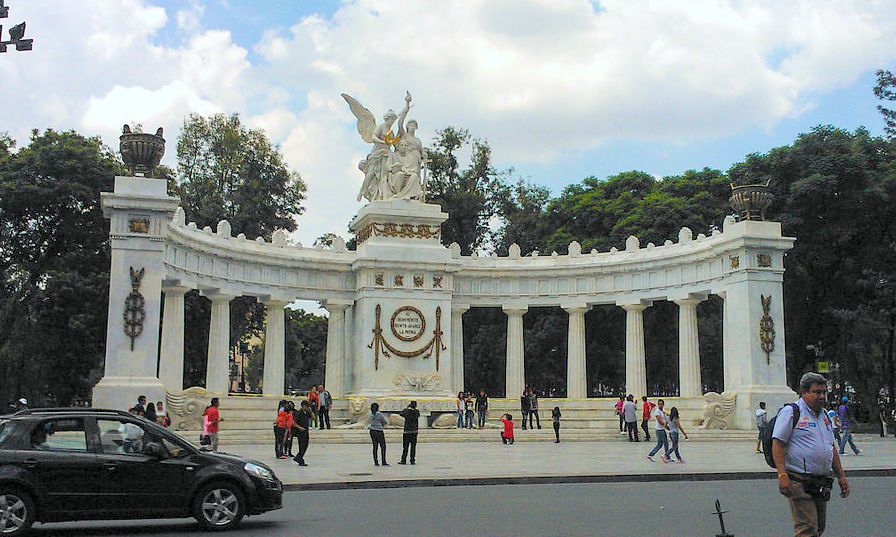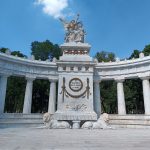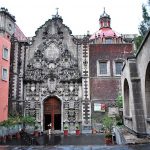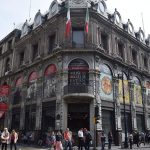
本尼托·华雷斯半圆形建筑是新古典主义纪念碑,是阿拉米达中央公园不可忽视的地标。
这座半圆形建筑采用了浓厚的希腊风格,有12根多立克式柱子支撑着同一风格的横梁和楣结构。中央的雕塑代表着本尼托·华雷斯,他的头顶是象征祖国的花冠。第二个寓言代表“法律”,手举火炬高举在他的头上。在下方,共和国的鹰展开翅膀,踏在新阿兹特克的花纹上,底座上躺着两只狮子。
中央柱上的饰章上写着:“致可赞美的本尼托·华雷斯,祖国”。
这座纪念碑的建造始于1906年,目的是庆祝华雷斯诞辰100周年。工程师们由波菲里奥·迪亚兹亲自指派,雕塑家则是意大利艺术家亚历山德罗·拉泽里尼。
这座本尼托·瓦雷斯半圆形纪念碑于1910年9月18日落成,并长期用于举办国家彩票抽奖活动。莫里斯科售货亭也座落于此,曾在海外辗转数年,重新回到墨西哥。当国家彩票机构迁移至此,这座纪念碑成为了数以千计的观光景点。
东行的波兰柯观光巴士,停靠在贝尼托·瓦雷斯半圆形纪念碑对面的胡安·胡亚雷斯大街,位在科尔普斯·克里斯蒂教堂前方。而西行的巴士会停在阿拉莫达中央大道以北,在弗朗茨·迈耶博物馆外的伊达尔戈大道上。从一侧到另一侧的步行大约需要五分钟。
 This monument is dedicated to the memory of President Benito Juárez, who defended the Mexicofrom internal wars and foreign invasions. The monument was built on one side of the Alameda Central.
Architect Heredia commissioned the sculptor Alesandro Lazzerini to complete a set of sculptures, and columns to form a semicircle of Doric columns topped by two pillars. In the center is a pair of lions and above them stands an empty tomb crowned by an eagle. In the center rises a set of sculptures depicting President Juarez seated, and behind him "The Law" and the "Goddess of Victory" crowning the president with laurels.
The monument was dedicated on September 18, 1910 by President Porfirio Diaz. It weighs approximately 70 tons and is composed of 1620 blocks of Carrera marble. The sculptural ensemble reaches seven meters in height.
This monument is dedicated to the memory of President Benito Juárez, who defended the Mexicofrom internal wars and foreign invasions. The monument was built on one side of the Alameda Central.
Architect Heredia commissioned the sculptor Alesandro Lazzerini to complete a set of sculptures, and columns to form a semicircle of Doric columns topped by two pillars. In the center is a pair of lions and above them stands an empty tomb crowned by an eagle. In the center rises a set of sculptures depicting President Juarez seated, and behind him "The Law" and the "Goddess of Victory" crowning the president with laurels.
The monument was dedicated on September 18, 1910 by President Porfirio Diaz. It weighs approximately 70 tons and is composed of 1620 blocks of Carrera marble. The sculptural ensemble reaches seven meters in height.
Heart of México Walking Route: Alameda - Madero
< < Alameda| Corpus Christi Temple > >
Proyecto “Corredor de Cultura Digital”
Nombre de la investigación: Investigación Centro Histórico, Monumentos, Edificios y Puntos de Interés (2023)
Dirección de investigación y diseño de Rutas: Acércate al Centro A.C. Guadalupe Gómez Collada
Coordinación e investigación histórica: Fideicomiso del Centro histórico Dir. Maestra Loredana Montes

Among the strongest places to see historical and colonial period art works . . .

Bellas Artes has long been an iconic symbol of Mexico City's culture and performing arts.

One of Pedro de Arrieta's most lasting contributions to the look and feel of the City.

One of the oldest places on today's calle Madero, the temple is only accessible through a remaining side chapel.

One of the most eclectic of museums, at home in one of the most dynamic of late 19th century buildings.